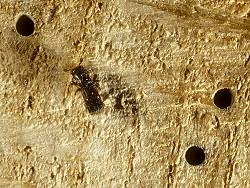Biotic factor that contributes to oak decline
 The wood boring beetle Platypus cylindrus infests and breeds in cut trees, windblown trees, standing dead and dying trees.
The wood boring beetle Platypus cylindrus infests and breeds in cut trees, windblown trees, standing dead and dying trees.
Like Agrilus biguttatus it was previously regarded as a rare beetle associated principally with ‘veteran’ oak trees, but took advantage of an abundance of breeding material and favourable conditions following the gales of 1987 after which populations grew rapidly in the south and south-east of England. Beetle numbers have never returned to pre-hurricane levels, possibly a consequence of a continuing supply of breeding material in the form of weakened oaks suffering from oak decline and dieback.
P. cylindrus appears to establish only in trees that are severely stressed or already dead and is not itself responsible for killing trees.
Typical signs of attack are piles of fibrous frass (similar to sawdust) on the bark surface (most evident on horizontally stacked logs) which mark the entry points of Platypus cylindrus adults. Once the breeding cycle is completed, emerging beetles leave exit holes, which are circular and around 1.6 mm in diameter.
The life history of Platypus cylindrus and options for management, both at the felling site and in the timber yard, are described in the following:
Oak pinhole borer (PDF-264K)
Revised: April 2010